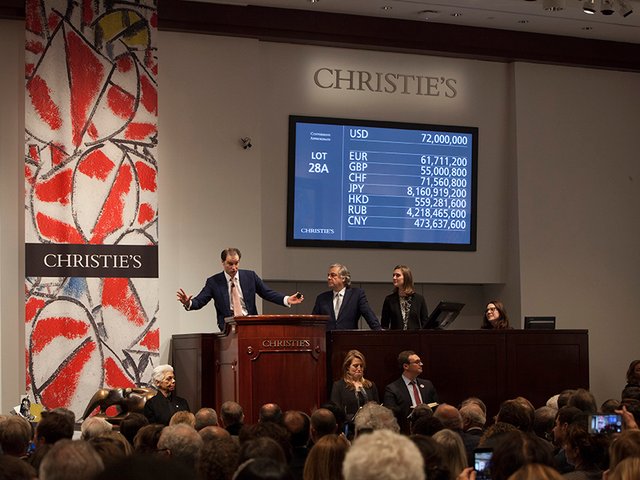“Someone will buy this,” said the auctioneer Andreas Rumbler, through gritted teeth, as opening bids beyond $35m for Claude Monet’s Meule (Grainstack) (1891) failed to materialise during the Impressionist and Modern art evening sale at Christie’s yesterday (16 November). The work carried no guarantee and a wave of nervous laughter rippled through the room. But then the bidding began. Over the next 14 minutes, the work inched past its estimate of around $45m and, during the final phone battle between a US and a Chinese bidder, Rumbler, the deputy chairman of Christie’s Switzerland, told the bidders “You have to hurry up now,” prompting a different kind of laughter altogether. The work sold for $72.5m hammer ($81.4m with fees) to a bidder on the phone with Christie's Senior Director Margot Rosenberg, setting a new record for Monet at auction.
Monet often painted a single subject in serial format, and other grainstacks are held by New York’s Metropolitan Museum of Art and the Museum of Fine Arts, Boston. But, as one of the final pieces in Monet's series, and one of the last in private hands, the painting attracted plenty of pre-sale interest.
It was the highlight of a sale that fetched $214.4m ($246.3m with fees), comfortably above the estimate of $202m, with a sell-through rate of 81%, putting to rest any lingering fears about the impact of the US election on the art market.
Wassily Kandinsky’s late work Rigide et courbé (1935), which once belonged to Solomon Guggenheim, was the second artist record of the night, selling for £20.6m ($23.3m with fees) after some especially slow bidding which, at one point, was going up in $100,000 increments. The work, which was guaranteed by a third party, was eventually bought by a US adviser in the room. “This work was the most interesting pricing exercise I’ve done all year. We had no comparative work to go on; it’s utterly unique and has been off the market since 1964,” said Olivier Camu, the deputy chairman of Impressionist and Modern art for Christie’s Europe.
The auction house fielded 11 works by Picasso, dating from before his Blue Period to the 1960s. Ten of the lots sold, including a striking earthenware sculpture of an owl, Le hibou (rouge et blanc) (1953), which sold for $2m hammer ($2.4m with fees), comfortably above its upper estimate of $1.5m, and a standout oil on canvas, Buste de femme (1938). Painted at the height of Picasso’s relationship with Dora Maar, it was the first time the work has appeared on the open market since 1988. After protracted bidding, the Japanese collector Yusaku Maezawa bought the painting for $20m hammer ($22.6m with fees; est $18m-$25m). Maezawa also picked up Basquiat’s Untitled (1982) for $57m with fees at Christie’s New York in May.
Bidding wore a little thin in parts, and a few major lots failed to sell. Picasso’s Tête de femme (Dora Maar) (1943) could not find a buyer at its estimate of $9m-$12m. Similarly, bidding for Paul Cézanne’s Paysage avec route et clocher (Île de France près de Melun) (1879-80) stopped at $9m, short of its lower estimate of $10m. “This is still a more cautious market and buyers are making studied decisions,” said Christie’s global president Jussi Pylkkanen at the press conference after the sale.
Continuing the trend across the Modern and contemporary categories at all houses, “it was a good, solid sale,” said the London- and New York-based dealer Nicholas Maclean, although he also believes that there is more activity in the private sphere.
CORRECTION: This article was amended on 17 November. Margot Rosenberg of Christie's is not in the auction house's private sales division as previously reported.



